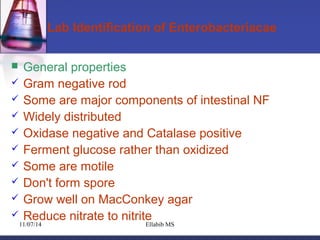
Lab identification of enterobacteriacae
- 1. Lab Identification of Enterobacteriacae General properties Gram negative rod Some are major components of intestinal NF Widely distributed Oxidase negative and Catalase positive Ferment glucose rather than oxidized Some are motile Don't form spore Grow well on MacConkey agar Reduce nitrate to nitrite 11/07/14 Ellabib MS
- 2. Human diseases Urinary and gastrointestinal infection Pneumonia and meningitis Abscesses and wound infection Septicemia Important species and diseases E. coli A. UTI B. Diarrhoea 1. Enteropathogenic E. coli (EPEC) cause infantile enteritis 2. Enterotoxigenic (ETEC) cause travellers diarrhoea 3. Enteroinvasive (EIEC) resemble shigelloses 4. Verocytotoxigenic (VITE) cause haemorrhagic colitis (bloody diarrhoea) Haemolytic uraemia syndrome C. Sepsis D. Meningitis in infants (K1 antigen capsule type) 11/07/14 Ellabib MS
- 3. Important species and diseases Shigellae Bloody and pus diarrhoea Shigellae dysenteriae and S. sonnei, S. flexneri Salmonella spp Salmonella thyphi (typhoid fever) Bacteremia and enterocolitis Klebsiella spp K. pneumoniae K. oxytaca Pneumoniae, UTI and bacteremia Hospital acquired infections 11/07/14 Ellabib MS
- 4. Important species and diseases Proteus spp UTI, bacteremia Kidney stone P. mirabilis and P. vulgaris Enterobacter spp UTI, nosocomial pathogen E. aerogenes (capsulated) E. cloacae and E. agglomerans 11/07/14 Ellabib MS
- 5. Important species and diseases Serratia spp Opportunistic hospital pathogen Neonatal bacteremia and pneumonia S. marcescens and S. liquifaciens Citrobacter spp UTI C. freundii Yersinia spp Y. pestis (plague) Y. enterolitica 11/07/14 Ellabib MS
- 6. Important species and diseases Other less encountered spp Providencia, Hafnis and Erwinia 11/07/14 Ellabib MS
- 7. Laboratory diagnosis Presumptive identification 1. Gram stained preparation (-v rod or cocco bacilli) 2. Colony morphology on blood agar Large Gray, dry, Mucoid or swarming 3. Red colonies on MacConkey agar Indicate organism can form acid 4. Biochemical tests for species identification 11/07/14 Ellabib MS
- 8. (-v rod) MacConkey agar 11/07/14 Ellabib MS
- 9. Group members differentiation 1. Glucose fermentation positive 2. Cytochrome oxidase test is negative 3. Nitrate is reduced to nitrite Carbohydrate utilization Not all carbohydrates are sugar Fermentation term is also misused Fermentation is an oxidation-reduction Take place in an anaerobic environment Substrate serve as final (H) acceptor Process detected by PH indicators Acidification may result from other pathway All bacteria metabolize carbohydrates are facultative anaerobic Utilization may not be under strictly anaerobic conditions 11/07/14 Ellabib MS
- 10. Basic principle of fermentation Glucose Formic acid Pyruvic acid Acetyl COA Acetic acid Butyric acid +Alcohol Acetaldehyde Succinic acid Butanediol Ethyl alcohol Propionic acid 11/07/14 Ellabib MS H2+CO2 Acetoin
- 11. B- Galactosidase and PNPG test To detect galactosidase enzyme Useful for lactose fermenters such as Some E. coli strain from Shigella sonnei Some strains of Citrobacter and S. arizonae (ONPG +V) from Salmonella spp (ONPG –v) The test measure enzyme only 11/07/14 Ellabib MS
- 12. Process of lactose in Enterobacteriacae lactos e glucose galactose β - galactoside bond β – galactoside permease glucose B-galactosidase galactose Glucose + galactose 11/07/14 Ellabib MS Mixed acids glucose Pyruvic acid
- 13. OPNG O- Nitrophenol -B-galactosidase (colourless) Enzyme ( B- galactosidase) O – Nitrophenol (yellow) 11/07/14 Ellabib MS
- 14. Cytochrome Oxidase test Do not use steel or nichrome wire loop Tetramethyl - p-phenylenediamine when it takes the electron from the last element (cytochrome oxidase) in the electron transport chain. Positive result give blue colour (10-20 second) 11/07/14 Ellabib MS
- 15. Detection of carbohydrates fermentation Media ingredients Trypticase, NaCl, phenol red, carbohydrate, distilled water and PH adjusted to 6.8 Fermentation indicated by yellow colour and gas formation by Durham tube 11/07/14 Ellabib MS
- 16. Kliger Iron agar or Triple sugar iron agar Media contain two or three sugar Contain ferric PH indicator (phenol red) Nitrogen source To differentiate lactose from non lactose Fermenter (KIA) Fermentation of sucrose (TSIA) Detection gas Detection of hydrogen sulphide production 11/07/14 Ellabib MS
- 17. Indol production ability of the organism to split indole from the amino acid tryptophan Tryptophanase enzyme Kovac's reagent (isoamyl alcohol, p- Dimethylaminobenzaldehyde, concentrated hydrochloric acid) to the culture broth Results: Positive result red color (occurring within a few seconds) Negative result yellow color 11/07/14 Ellabib MS
- 18. Methyl Red Test MR test is a quantitative test for acid production, requiring positive organism to produce strong acids (lactic, acetic, formic) from glucose via the mixed acid fermentation pathway only those organism that can maintain low PH of about ph 4-4.5 can be called methyl red – positive organisms that are MR (+) are always VP (-) Klebsiella 11/07/14 Ellabib MS E. coli
- 19. Voges proskauer Test Acetoin Diacethyl KOH+Air +Naphthol+creatine Red complex 11/07/14 Ellabib MS Klebsiella E. coli
- 20. Citrate Test a test depends upon the ability of the organism, to utilize citrate as the sole source of carbon and energy growth Simmon’s Citrate Agar Kosher’s Media bromthymol blue, a pH indicator with a range of 6.0 to 7.6 uninoculated Simmon's citrate agar has a pH of 6.9, so it is an intermediate green color (neutral pH) Growth of bacteria in the media leads to development of a Prussian blue color at more alkaline pH's (around 7.6) (positive citrate) Klebsiella, Salmonella, Citrobacter Escherichia 11/07/14 Ellabib MS and Shigella
